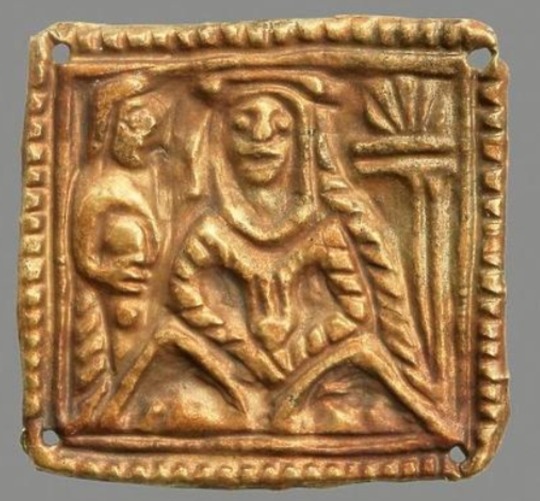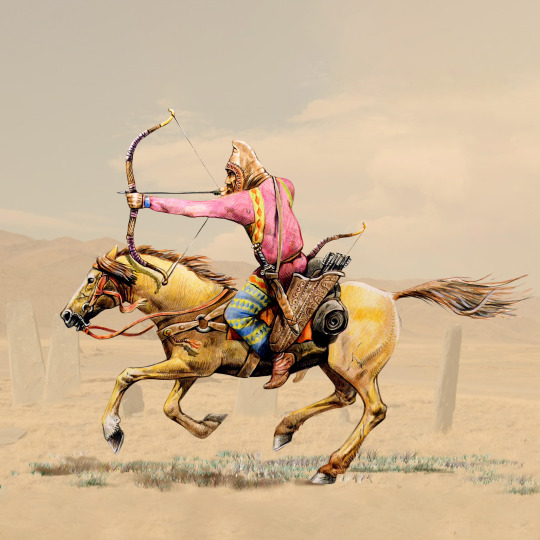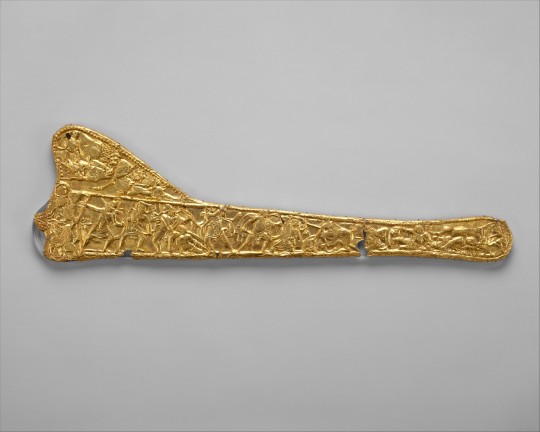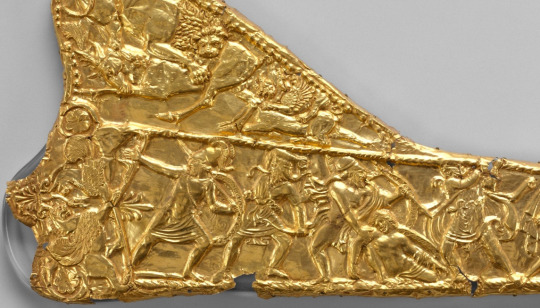#scythians
Text

2,300-Year-Old Plush Bird from the Altai Mountains of Siberia (c.400-300 BCE): crafted with a felt body and reindeer-fur stuffing, all of which remains intact
This artifact was sealed within the frozen barrows of Pazyryk, Siberia, for more than two millennia, where a unique microclimate enabled it to be preserved. The permafrost ice lense formation that runs below the barrows provided an insulating layer, preventing the soil from heating during the summer and allowing it to quickly freeze during the winter; these conditions produced a separate microclimate within the stone walls of the barrows themselves, thereby aiding in the preservation of the artifacts inside.
This is just one of the many well-preserved artifacts that have been found at Pazyryk. These artifacts are attributed to the Scythian/Altaic cultures.
Currently housed at the Hermitage Museum.
#archaeology#anthropology#history#artifact#artifacts#siberia#scythians#archeology#museum#amazing#interesting#stuffed animals#ancient history#prehistoric#crafting#felt art#art#prehistoric art#hermitage museum#human nature
45K notes
·
View notes
Text

Vasily A. Prokhorov, 1881: Skeleton of a Scythian queen and her jewelry, found in the Chertomlyk barrow, near Nikopol, Katerynoslavsk Governorate (today, Ukraine).
307 notes
·
View notes
Text
youtube
4th Century BC Scythian Gear
from Full Tilt Jousting
85 notes
·
View notes
Text
"Our results demonstrate that Scythians primarily used domesticated species such as sheep, goat, cattle, and horse for the production of leather, while the furs were made of wild animals such as fox, squirrel and feline species. The surprise discovery is the presence of two human skin samples, which for the first time provide direct evidence of the ancient Greek historian Herodotus’ claim that Scythians used the skin of their dead enemies to manufacture leather trophy items, such as quiver covers."
I love it whenever one of Herodotus' wild claims is proven right.
105 notes
·
View notes
Text

Scythian Archer on a Greek Vase, 520-500 BCE
Made in: Attica (Greece)
Excavated in Vulci
#art#scythian#scythians#archer#greek#greece#cradle of civilization#southern europe#fine art#european art#classical art#europe#european#classic art#male#oil painting#fine arts#mediterranean#europa#attica#vulci#phrigian cap
234 notes
·
View notes
Text
Male archeologists/historians are dumb af like they can discover a culture where only women are buried with riches depicting WOMEN ON THRONES BUSTING THEIR PUSSIES WIDE OPEN and men portrayed only as expendable resources in wars then being like ah yeah this is a patriarchy just like us ❤️

106 notes
·
View notes
Photo

“Women were included in the ranks of this fully mobilized society. Prokopios, aware, of course, of the legends of the Amazons whose origins he traces to the region of the Sabirs, reports that in the aftermath of "Hunnic" (i.e. Sabir) raids into Byzantine territory, the bodies of women warriors were found among the enemy dead. East Roman or Byzantine sources also knew of women rulers among the nomads. Malalas, among others, mentions the Sabir Queen Boa/Boarez/Boareks who ruled some 100,000 people and could field an army of 20,000. In 576 a Byzantine embassy to the Turks went through the territory of 'Akkayai; "which is the name of the woman who rules the Scythians there, having been appointed at that time by Anagai, chief of the tribe of the Utigurs." The involvement of women in governance (and hence in military affairs) was quite old in the steppe and was remarked on by the Classical Greek accounts of the Iranian Sarmatians. It was also much in evidence in the Cinggisid empire.
These traditions undoubtedly stemmed from the necessities of nomadic life in which the whole of society was mobilized. Ibn al-Faqih, embellishing on tales that probably went back to the Amazons of Herodotos, says of one of the Turkic towns that their "women fight well together with them," adding that the women were very dissolute and even raped the men. Less fanciful evidence is found in the Jiu Tangshu which, s.a. 835, reports that the Uygur Qagan presented the Tang emperor with "seven women archers skillful on horseback.” Anna Komnena tells of a Byzantine soldier who was unhorsed with an iron grapple and captured by one of the women defenders as he charged the circled wagons of the Pecenegs. Women warriors were known among the already Islamized Turkmen tribes of fifteenth century Anatolia and quite possibly among the Ottoman gazfs (cf. the Bacryan-z Rum "sisters of Rum")”.
Golden Peter B., “War and warfare in the pre-cinggissid steppes of Eurasia” in: Di Cosmo Nicola (ed.), War and warfare in Inner Asian History
#history#women in history#warrior women#warriors#Akkayai#6th century#historyedit#historyblr#central asia#scythians#sarmatians
59 notes
·
View notes
Text

Ceramic of man and cow from the Kingdom of Khotan 7th-9th C. CE
"The origin of the name "Hephthalites" is unknown, it may stem either from a Khotanese word *Hitala meaning "Strong", from hypothetical Sogdian *Heβtalīt, plural of *Heβtalak, or from postulated Middle Persian *haft āl "the Seven Al"
In the late 5th century CE they expanded eastward through the Pamir Mountains, which are comparatively easy to cross, as did the Kushans before them, due to the presence of convenient plateaus between high peaks. They occupied the western Tarim Basin (Kashgar and Khotan), taking control of the area from the Ruanruans, who had been collecting heavy tribute from the oasis cities, but were now weakening under the assaults of the Chinese Northern Wei dynasty. In 479 they took the east end of the Tarim Basin, around the region of Turfan.
When Khosrow I died in 579, the Hephthalites of Tokharistan and Khotan took advantage of the situation to rebel against the Sasanians, but their efforts were obliterated by the Turks."
-taken from Wikipedia
92 notes
·
View notes
Text

The cheekpiece of a horse's bit from Scythia, 600s BCE. The Scythians, who ranged throughout southeastern Europe and central Asia, were considered to be expert horsemen -- and women (archaeologists have found many women's graves full of objects that indicate that they were horseback warriors).
{WHF} {Ko-Fi} {Medium}
150 notes
·
View notes
Text
A retelling of Peter Pan in ancient Greece
Change Peter to Artemis and the Lost Boys to her huntresses.
Change Tiger Lily's people to Scythian raiders, but depict them more respectfully than the "Indians" in Peter Pan tend to be portrayed. Maybe even have the Tiger Lily equivalent join Artemis's hunt?
Tinker Bell could be some sort of nymph.
Keep the mermaids and pirates, as the ancient Mediterranean had plenty of mermaid tales and piracy.
Not sure if the Wendy equivalent should join the hunt in the end, or return home like she does in the original novel. In either case she's probably gay, though. If she does go home, she'll presumably always remember Artemis as "the one that got away." Though maybe Wendy ends up learning poetry from Sappho, which would cheer things up a bit.
#ancient greece#greece#greek mythology#mythology#artemis#scythia#scythian#scythians#sappho#sapphic#gay#lesbian#queer#lgbtq+#women loving women#wlw#peter pan#lost boys#wendy darling#tinker bell#tinkerbell#j. m. barrie#j.m. barrie#j m barrie#jm barrie
260 notes
·
View notes
Text



3rd century Scythian mummy discovered in Siberia in 1949 with some amazing tiger tattoo artistry.
14 notes
·
View notes
Text
A new study has proven that the once doubted words of Herodotus were right, Scythians did use the scalps and skin of their slain enemies as trophies, repurposing it to make arrow quivers and hand towels.
21 notes
·
View notes
Text

Scythian archer with his bow, quiver and gorytos. Illustration by Sammy33/Shutterstock.
Learn more / Daha fazlası
Gorytos https://www.archaeologs.com/w/gorytos/
#archaeologs#archaeology#archaeological#dictionary#history#scythians#archer#bow#quiver#gorytos#weapons#ancient weapons#illustration#arkeoloji#tarih#sanat#art
39 notes
·
View notes
Text


Sheet gold decoration for a sword scabbard, Scythian, 4th century BC
from The Metropolitan Museum of Art
171 notes
·
View notes
Text

Comb in the Scythian style. Materials: beech, bog oak, amaranth, amber, turquoise.
#woodworking#arts and crafts#handmadeartwork#tumblr artist#handmade#woodcarving#crafts#archaic ancient crafts history panel primitive pyrography traditionalart woodworking historyart#history#scythians#archeology#handmade art#art#bijouterie#artwork#dragon art#dragons#artists on tumblr#woodart#woodcraft#woodwork
19 notes
·
View notes
Text
Oh, this is all kinds of yuck.
19 notes
·
View notes